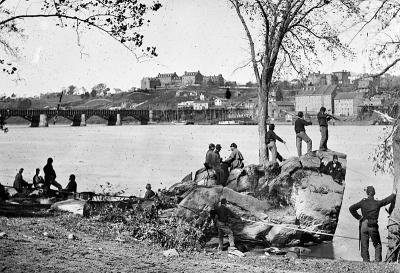The Civil War was one of the most difficult periods for the nation and Georgetown university. President John Early, who served from 1858 to 1865, oversaw a turbulent time of division among the student body, the requisition of the campus for union soldiers, and a dramatic decrease in enrollment. Georgetown, located right below the Mason-Dixon line and at the heart of the nation's capital, had a front seat to some of the most important events during the Civil War.
The Years Leading up to The War
On 11 December 1859, the Philodemic Society, Georgetown's oldest debate union, discussed the question, "Should the South now secede?" This debate garnered a lot of controversy and spanned multiple meetings over the course of two weeks. The Philodemic eventually affirmed the resolution and agreed that the South should secede. The verdict incited a brawl between Philodemic members from the North and South which, in turn, led to the suspension of all Philodemic meetings for that year.
After the election of President Lincoln and the secession of South Carolina, there was a dramatic drop in the enrollment of southern students in institutions across the Northeast. At Georgetown, during the 1859-60 academic year, half of the students were from the south. Even after the secession of South Carolina, southern students still accounted for 46.9% of the total population at Georgetown.1 President Early commented on the mounting tensions and warned that the precarious position of DC as the border between the North and South could potentially make the area one of the theaters of war.2 When Confederate forces attacked Fort Sumter, parents immediately began to remove their children from Georgetown. Students who sympathized with either side began to drop out to enlist.
The Civil War (1861-65)
Out of 1085 Georgetown alumni who fought in the Civil War, 867 soldiers fought for the Confederates.
Jesuits feared that nativism would lead to an attack on the Catholic church. Even before the Civil War, Jesuits, the majority of whom were Confederate sympathizers, kept a strict policy of neutrality at Georgetown. The Philodemic Society, under the administrations' policy, also debated on vague and superficial topics such as "Are mental enjoyments greater than physical?" and "Has the invention of printing been beneficial to man?" Despite attempts to stay neutral, the remaining students on campus continued to demonstrate support for one side or the other through various means, such as wearing their allegiances on their sleeves.
In May 1861, Lincoln's volunteer army of the Potomac began to look for sites in Washington to accommodate the military units. After receiving permission from President Early, around 1400 Union soldiers were billeted briefly in Old South and other College buildings. Students had to quickly move out of buildings on the south of the Quadrangle (Gervase Hall, Isaac Hawkins Hall, Maguire Hall). When soldiers arrived, students who were Confederate sympathizers shouted: "Three cheers for Jeff Davis and the Southern Confederacy."3 A few days later, President Lincoln and his cabinet members visited the campus.
From 1860-61 students continued to leave, and directors of the college decided that Georgetown would temporarily halt awarding degrees to students. By the beginning of 1862, Georgetown considered whether they should convert the school into a Jesuit seminary since the college had lost its traditional base of students who were primarily from the south. In the academic year of 1861-62, only 50 students enrolled. The war also decreased the college's ability to provide financial aid and scholarships. For the first time in four decades, Georgetown raised its tuition. For end-of-year ceremonies, the college had to melt down silver spoons on campus to fabricate the silver medals awarded to students for academic achievement. During this academic year, Georgetown buildings were converted into an army hospital for union soldiers. The students and directors were ordered to refrain from any mention of politics or the war.
Despite the precarious time of the Civil War where Georgetown came close to shutting down, in the fall of 1865, Georgetown resumed classes with more than 300 students.
Lincoln's Assassination
John Wilkes Booth shot President Lincoln in Ford's Theatre, shouting "Sic semper tyrannis. The South is avenged." The next day, Georgetown mourned the death of their president. Black crepe was draped over buildings. Upon investigation, several Georgetown alumni were implicated in the conspiracy to assassinate Lincoln. Among them included David Herold (C1855-58) and Samuel Bland Arnold (C1844-45). Herold temporarily sheltered Booth after the assassination, with a fellow alum Samuel Mudd (C1851-52). In total, three Georgetown alumni were among the six convicted for the conspiracy to assassinate Lincoln.(p.246-7) Herold was hanged for his crime on July 7.
The Aftermath of the Civil War
Senator Stephen R. Mallory (C'1869) commented on the surprisingly unified and peaceful campus environment when he enrolled at Georgetown in 1865. He said in a letter, "Strange to say, however, within the College walls there was no evidence of sectional bitterness... this was not due to the absence of partisan feelings among them, but rather to the prompting of good sense that realized the inutility and folly of such controversies."3
In 1876, the university selected blue and gray for the newly formed Boat Club to express the unity between the North and the South within the student body. In 1961, on the centennial of the Civil War, the Alumni Association added a plaque to the porch of Old North to commemorate Georgetown students who had served in the War.
- 1Curran, Robert Emmett. "The Bicentennial History of Georgetown University: From Academy to University, 1789-1889,"Georgetown University Press, Washington, D.C. 199,p. 222
- 2Ibid. p. 222
- 3Conway, Lynn. "Shades of Blue and Gray: Georgetown and the Civil War." Booth Family Center for Special Collections, Mar 14, 2011. https://library.georgetown.edu/exhibition/shades-blue-and-gray-georgetown-and-civil-war
- 3Conway, "Shades of Blue and Gray: Georgetown and the Civil War."


